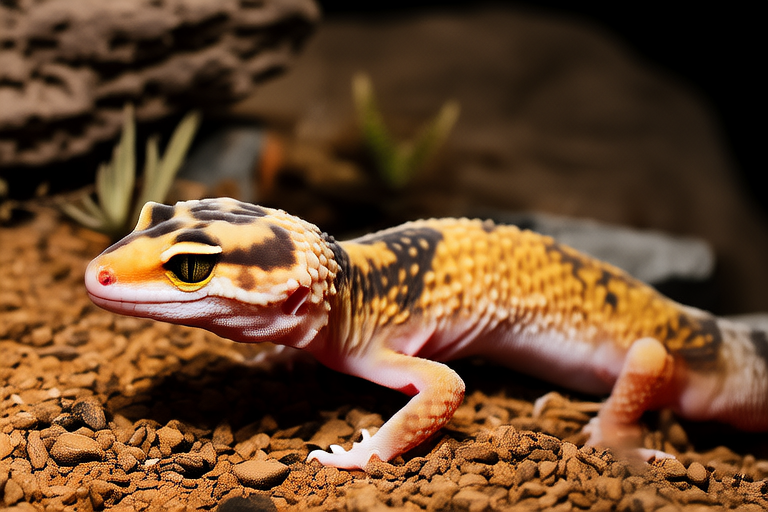Comprehensive Leopard Gecko Care Guide
Habitat Setup
Leopard geckos are small lizards that require specific environmental conditions to thrive. The ideal habitat size for a single adult leopard gecko is approximately 10 gallons, but larger enclosures can be used if you have more than one gecko. The enclosure should be equipped with a secure lid to prevent escapes. A substrate of paper towels or reptile carpet is recommended for ease of cleaning and safety. Avoid using sand or other loose substrates as they can cause impaction if ingested.
The temperature gradient within the enclosure should range from 78°F to 90°F (26°C to 32°C), with a hotspot of around 95°F (35°C) provided by an under-tank heater or ceramic heat emitter. Ensure there are no hot spots on the surface of the substrate that could burn your gecko. The ambient temperature should drop slightly at night, ideally between 68°F and 75°F (20°C to 24°C).
A hiding spot made from a commercial reptile cave or a simple cardboard box with an entrance hole is essential. Leopard geckos need places to retreat and feel secure. Additionally, provide climbing structures like branches or rocks, but ensure they are stable and safe. A shallow water dish should be available at all times for drinking and soaking. Regularly clean the water dish to maintain hygiene.
Diet Requirements
Leopard geckos are insectivores and their diet primarily consists of crickets, dubia roaches, mealworms, and waxworms. It’s important to gut-load insects before feeding them to your gecko. Gut-loading involves feeding the insects nutritious foods such as fruits, vegetables, and commercial insect gut-load diets. This ensures that the nutrients from these foods are passed on to your gecko when it eats the insects.
Vitamin and mineral supplements are crucial for maintaining your gecko’s health. Use a calcium supplement without vitamin D3 for daily feedings and a multivitamin supplement once or twice a week. Dust the insects with the supplements just before feeding. Over-supplementation can lead to health issues, so follow the manufacturer’s guidelines carefully. Offer a variety of prey items to ensure a balanced diet.
Feeding frequency depends on the age and size of your gecko. Juvenile geckos should be fed daily, while adults can be fed every two to three days. Always remove any uneaten insects after feeding to prevent them from biting or stressing your gecko.
Health Care
Regular veterinary check-ups are important for monitoring your gecko’s overall health. Look for signs of illness such as lethargy, loss of appetite, difficulty breathing, or unusual skin coloration. Common health issues include metabolic bone disease (MBD), caused by calcium deficiency; impaction, often due to inappropriate substrate ingestion; and respiratory infections, which may result from improper humidity levels or temperatures.
Maintaining proper hygiene is key to preventing many health problems. Clean the enclosure weekly, removing waste and replacing soiled substrate. Disinfect the enclosure and accessories using a reptile-safe disinfectant, then rinse thoroughly and allow everything to dry completely before returning your gecko to its home. Regular handling and observation will help you become familiar with your gecko’s normal behavior, making it easier to notice any changes that might indicate a problem.
Breeding Basics
Breeding leopard geckos requires careful planning and attention to detail. To breed successfully, you’ll need a male and female gecko. Males should be housed separately from females except during breeding periods. Breeding season typically occurs in late winter or early spring. Before introducing the pair, ensure both geckos are healthy and well-fed.
During breeding, males may become territorial and aggressive towards each other. Provide plenty of hiding spots and monitor interactions closely. Females can lay eggs several times throughout the breeding season, usually laying two eggs per clutch. Eggs should be placed in an incubator set to the desired incubation temperature, which varies depending on whether you want males or females. Incubation takes about 45 to 60 days.
Newborn hatchlings require specialized care, including smaller food items and a separate enclosure to prevent cannibalism. Monitor their growth and development closely to ensure they are thriving.
Common Behaviors
Leopard geckos exhibit several interesting behaviors that make them fascinating pets. They are generally nocturnal, meaning they are most active during the evening and night. During the day, they tend to rest in dark, quiet areas within their enclosure. Geckos communicate through body language and vocalizations, though they are relatively quiet compared to some other lizard species.
Autotomy, or tail dropping, is another notable behavior. When threatened, leopard geckos can voluntarily shed their tails as a defense mechanism. The tail will regenerate over time, but the new one won’t look exactly like the original. Handling your gecko gently and providing secure hiding spots can help reduce the likelihood of tail loss.
Leopard geckos also engage in digging behavior, especially when looking for a place to hide or lay eggs. Providing a substrate that allows for digging, such as coconut fiber or reptile bedding, can satisfy this natural instinct.
Essential Tips for Beginners and Experienced Owners
For beginners, understanding the basic needs of leopard geckos is crucial. Research thoroughly before bringing one home, and consider joining online communities or forums where you can ask questions and share experiences. Experienced owners should continue learning about advancements in husbandry techniques and stay informed about potential health risks.
No matter your level of experience, always prioritize the welfare of your pet. Pay close attention to changes in behavior, appearance, or appetite, and seek professional advice promptly if you suspect something is wrong. Handling your gecko regularly helps build trust and strengthens the bond between you and your pet.
